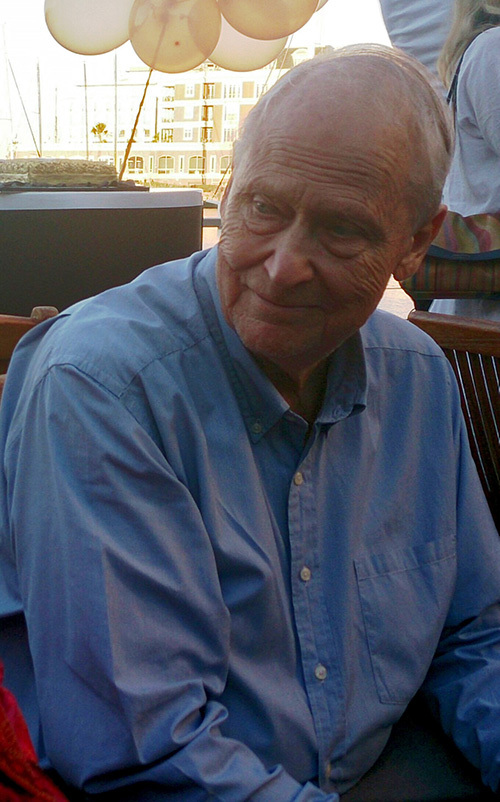Bruce Arnott: 1938–2018
19 July 2018 | Story Kim Gurney. Photo Supplied.
News about the death of one of South Africa’s foremost sculptors, Bruce Arnott, sent me straight to a public sculpture to bid farewell. His Alma Mater is an elegant and moving tribute to knowledge that is fittingly installed on the campus of the University of Cape Town (UCT). It depicts a goddess-like Caryatid figure atop a tall column; she holds symbols of learning in her hands and bears a weighted headdress with dignified aplomb.
But the telling detail – and in Arnott’s work, there is always a telling detail – is the chameleon perched triumphantly atop her headdress and its compatriot that stealthily climbs the side of the column towards the regal figure. Its beady eyes and curled tail signal a sly mischief that cuts to the heart of Arnott’s work: the redemptive gesture.
There is always something in his artworks to hold onto – a hopefulness that the future may still turn out better or, at the least, that a wry sense of humour about our fraught predicament as human beings might just be our saving grace. The playful chameleon is everything. And without it, Alma Mater would be an altogether different entity, more imperious and less appealing. It is the liberatory potential, however tenuous, of the chameleon’s disruption of power norms that Arnott leaves us in his own wake.
It is this kind of attention to telling detail that Arnott also helped instill in his students at UCT’s Michaelis School of Fine Art. He joined the teaching staff in 1978, when conceptual art was on the rise, to reaffirm technical artfulness, and he established the school’s bronze foundry. He later became the institution’s director (1989–93) and ultimately Professor Emeritus of Fine Art. Arnott was a Michaelis graduate himself: he collected the highly regarded Michaelis Prize (1961) along with an MA in Fine Art.
After graduating, Arnott joined the South African National Gallery (SANG) where he spent about a decade. During this time, he conducted a British Council scholarship at London University’s Courtauld Institute of Art (1964–65), researching the influence of Western Central African sculpture on Western art. He later became assistant director of SANG (1970–72) where he is credited with being among the first to promote African art in a public gallery, as well as defending the independence of the institution. He also curated important shows like African Art in Metal (1970).
Arnott subsequently spent several years as a subsistence farmer in his much-loved Drakensberg mountains in KwaZulu-Natal, where he was born and grew up. He built his own farmhouse and art studio, an experiment in self-sufficiency that extended to his artworks, forging sculptures from clay dug up on the grounds and melting lead roof washers for casting material. This temporary opt-out of the market economy was subversive and inspired by a deep love for nature and abiding concern with ecological issues.
Arnott then joined Michaelis staff and retired from teaching 25 years later in 2003. He also made numerous literary contributions. He regularly articulated a vital place for the visual arts in a society with pressing sociopolitical concerns, and wrote about the work of other artists, including a catalogue raisonné on his former Michaelis lecturer Lippy Lipshitz. He was the founder editor (1990) of Artworks in Progress, the Michaelis staff journal.
Arnott’s singular aesthetic was anchored upon a perfectionist’s eye that shared the chameleon’s stereoscopic vision. A single withering look could fell a bad idea. The same eye profoundly cared about the kinds of forms that were to be released into the world, and Arnott brought every consideration into his own works until they embodied what he was articulating with a precise and transporting visual economy.
This sought-after fusion of form and content is where Arnott excelled, and its elegance lent his artworks an accessibility. But that was also due to an uncanny ability to communicate in imagery drawn from a collective intellectual pool stretching back to a more primordial time. This pool synthesises what he called “a notional submerged mainstream” in Western European art with its roots in the prehistoric, ancient, tribal and folkloristic. His Green Man is a good example, drawing as it does from Western Druidic traditions, Jungian archetypes, Sufism and alchemy; but also Ivory Coast pendant masks and Zimbabwean San painted figures.
In this Afro-European synthesis, Arnott tapped into a less linear kind of awareness to which any viewer can readily respond, leavened by what he called the inspirational comedic energy of the pre-Renaissance carnivalesque. He preferred to let his artworks speak for themselves and they do so in a timbre that is surprisingly clear considering the impressive arc of historical, mythological and literary references they describe.
These range from the Neolithic age to pre-classical Greek and African synthesist sculpture, from notions of the prophetic in cultures as diverse as Celtic, San and Greek to engagement with contemporary artists. The articulations between these references function as interfaces – in the artist’s description, “interfaces between myth and history and between history and the present”. It is a respectful articulation that takes a certain licence with the past but is mindful of its original context, to hybridise a poetic myth that time-travels.
Arnott produced a body of work since the early 1960s, mainly in bronze but also lead, resin, fibreglass, stone and wood, for public installation and on a more intimate scale. He exhibited in numerous exhibitions: his first solo was at the Wolpe Gallery (1967) and latest at the Irma Stern Museum (2004) and Iona estate in Elgin (2012 and 2013), where he held a retrospective. Arnott was included in the São Paulo Art Biennial (1964) and the landmark Tributaries exhibition in Johannesburg (1985).
His work is represented in major collections and prominent public spaces. Most familiar, perhaps, are his iconic public sculptures marking the country’s two key museum entrances: Iziko’s SANG, where the human-animal hybrid Numinous Beast reigns, and the Johannesburg Art Gallery. Outside the latter stands Citizen, a two-metre-high bronze that won the 1985 Johannesburg Centenary Sculpture Competition.
Mounted on a stone-clad plinth, the artwork depicts a pompous businessman mid-stride on incongruously dainty feet with a newspaper tucked under one arm and walking cane upright in the other. This caricature is completed by a bowler hat and prominent cigar protruding horizontally from Citizen’s mouth.
This witty send-up of a heroic genre of monumental art has accrued new associations over the years, including at one time a patina of grilled sausage from street vendors encamped at its feet. In addition, the solid brass cane was “regularly liberated by the scrap-metal collectors, and carefully restored by the gallery, in a reciprocal exchange of wealth and culture that suggests a subliminal understanding of some of its precepts”, as Arnott related in his 2003 inaugural lecture.
Arnott’s oeuvre has yet to be fully appreciated, owing partly to a self-effacing and sceptical manner that first and foremost sought to serve the artwork rather than the vagaries of the broader artworld. After he retired from UCT, Arnott continued to produce art from his Cape Town studio until his death from illness, late on Thursday, 19 July 2018.
He is survived by his wife, Mari, their children Matthew and Ariane, his daughter Dinah and his son Stephen.
 This work is licensed under a Creative Commons Attribution-NoDerivatives 4.0 International License.
This work is licensed under a Creative Commons Attribution-NoDerivatives 4.0 International License.
Please view the republishing articles page for more information.









